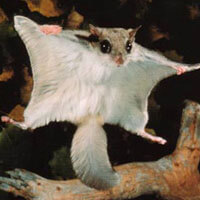Habits
Southern flying squirrels consume fruit and nuts from red and white oak, hickory and beech trees and they store mainly acorns for the winter. They also eat insects, mushrooms, bird eggs and plants. From tree tops, flying squirrels can begin glides from both running or from still positions and coast skillfully in the air creating 90 degree turns avoiding anything in their path. However, they are not graceful on land and typically hide rather than attempt an escape from predators.
Southern flying squirrels are social creatures and occasionally fly together in groups. These pesky critters can multiply rapidly inside your home creating a need for Atlanta squirrel control. Flying squirrels save significantly more energy by gathering in dens when seasonal temperatures drop. They sometimes allow unrelated individuals for the addition of their heat energy.
Habitat
The southern flying squirrel is typically found in the southeastern forests of North America where hickory, maple, poplar, oakand beech trees are plentiful and provide a desirable habitat. Southern flying squirrels may exist in deeply wooded suburban areas, but they do not occur in great amounts in these regions.
The size of the home range of southern flying squirrels differs significantly; it is larger in males than females perhaps to increase the probability of encountering mates.
 Male home ranges have a surplus of food as they are correlated with more red oaks and white oaks. In contrast, female home ranges contain less food resources and more nesting sites probably to evade interaction with other squirrels while nurturing their young. One of the more annoying feeding habits is storing food inside attic walls. People with flying squirrels in their attics often mention they hear these squirrels rolling the food around in the attic. This behavior creates a need for Atlanta squirrel control.
Male home ranges have a surplus of food as they are correlated with more red oaks and white oaks. In contrast, female home ranges contain less food resources and more nesting sites probably to evade interaction with other squirrels while nurturing their young. One of the more annoying feeding habits is storing food inside attic walls. People with flying squirrels in their attics often mention they hear these squirrels rolling the food around in the attic. This behavior creates a need for Atlanta squirrel control.
Southern flying squirrels nest in hollows, woodpecker holes, or build nests from leaves and sticks. Leaf nests are used as both protection and a resting location predominantly in summer, while holes are used chiefly used for breeding and for the winter. Openings used by southern flying squirrels are found in small crevices merely centimeters in diameter or in similarly sized openings in trees several meters above the ground.
Atlanta Squirrel Control
Flying squirrel behavior in Atlanta, GA will lead these gliding critters into your home or building roof and attic during the cooler months. The attic and walls of a Georgia home create a great atmosphere for them to live in and raise young flying squirrels.
Flying squirrels reproduce year round but there are two peaks of breeding in the Spring and Fall. These younger squirrels, if not trapped and removed from the attic, will return and have more babies, continuing the cycle. Flying squirrel colonies can number very high inside a home.
Trapping squirrels can be a difficult task for a homeowner who doesn’t understand proper trapping techniques. Squirrels in your home, crawlspace or attic can be very frustrating.
There are quite a few gimmicks online and at stores sold as an Atlanta squirrel control repellant. There is no real, effective squirrel repellant. These repellents are a waste of time and money that could be spent on a more permanent control method. They are not effective for squirrel control. Trapping and exclusion is the most successful way of dealing with an irritating flying squirrel problem.
If you do not recognize the signs of flying squirrels and how squirrels move in your attic than you may decide to leave squirrel trapping to the professional Atlanta squirrel control technician like an Urban Wildlife Control trapper.
Georgia Squirrel Removal catches thousands of squirrels from hundreds of homes every year. Once we remove them from your home we can give you a proper quote to correctly exclude them from your home permanently and make the suitable maintenance suggestions for the home and property. This process is an excellent Atlanta squirrel control option, if you are looking flying squirrel removal near me service.
